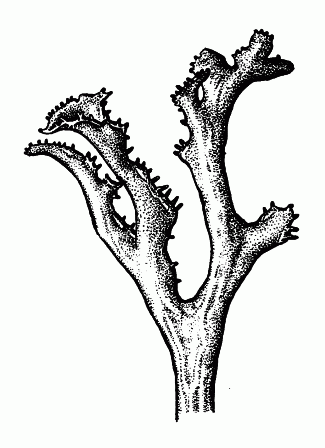Cetraria ericetorum Opiz (Räsänen) Kärnef
Hyphenated icelandmoss
Parmeliaceae
Introduction to the Lichens
Hyphenated icelandmoss
Parmeliaceae
Introduction to the Lichens
Map
Distribution of Cetraria ericetorum unavailable
Species Information
General:
Small to large stratified foliose lichens, corticate above and below, sorediate or not, lobes rather closely appressed to semi-erect or erect, short to more often elongate, averaging to 0.5–10 (–12) mm wide, thin to somewhat thick, occasionally bearing protruberant marginal pycnidia or cilia. Upper surface brownish, blackish, or brightly coloured; lower surface coloured alike with upper surface, often lacking rhizines. Medulla white (rarely yellow). Photobiont green. Apothecia located along lobe margins, disc brown or black; spores simple, spherical or ellipsoid, colourless, 8 per ascus.
Notes: Thirty-eight species of Cetraria are reported for North America. Nineteen of these occur in B.C. As presently delimited, Cetraria is a heterogeneous genus. Although several species groups are segregated from it as distinct genera (e.g. Asahinea, Cetrelia, Esslingeriana, Masonhalea, Platismatia and Vulpicida), a number of other species and species groups also deserve generic rank. Recently Hale (1987) transfered some of these to Tuckermannopsis. This disposition, however, seems more nomenclatural than taxonomic and is not followed here. Also not accepted here (pending further study) is the separate genus Allocetraria (Randlane and Saag 1992).
Species description:
Upper surface essentially dark: olive-green, brown or blackish AND Soredia absent; true isidia also absent AND Growing over bark, wood, earth or humus AND Over earth, humus or occasionally on branches at bases of shrubs; pseudocyphellae present or absent over lower surface; lobes generally elongate, margins often bearing short projections and/or cilia AND Lobes averaging to more than 2 mm wide, often concave; pseudocyphellae present or absent AND Lobe margins lacking cilia (Note: marginal projections may, however, be present, these averaging to 0.1–1 mm long); lobes at most dark brown; distribution various AND Medulla KC-; ecology and distribution various AND Lobes strongly concave to conspicuously inrolled along margins, with or without distinct central axis that runs length of lobes AND Pseudocyphellae more or less submarginal over lower surface (i.e., restricted to near lobe margins) AND Thallus lobes usually dichotomously branched, central axis usually not running length of lobes; pseudocyphellae distributed in discontinuous patches or forming a narrow line averaging 0.1–0.2 mm wide; widespread; medulla PD-
Comments:
The type locality of ssp. reticulata is given as “Kamloops.”
Reactions:
AND
Lobes dark olive-green to blackish or, if distinctly greyish or brownish, then finely dissected and shrub-like at maturity AND
Lobes dark olive-green to blackish, usually averaging to more than 1 mm wide; apothecial disc blackish; primarily in
Contents:
Norstictic and stictic acids (occasionally in trace amounts, rarely absent).
Source: Lichens of British Columbia
Illustration

If more than one illustration is available for a species (e.g., separate illustrations were provided for two subspecies) then links to the separate images will be provided below. Note that individual subspecies or varietal illustrations are not always available.
Illustration By: Trevor Goward
Habitat and Range
Habitat: Frequent over ground in open inland forests and alpine sitesWorld Distribution: N Am, N to AK, S to OR.
Source: Lichens of British Columbia